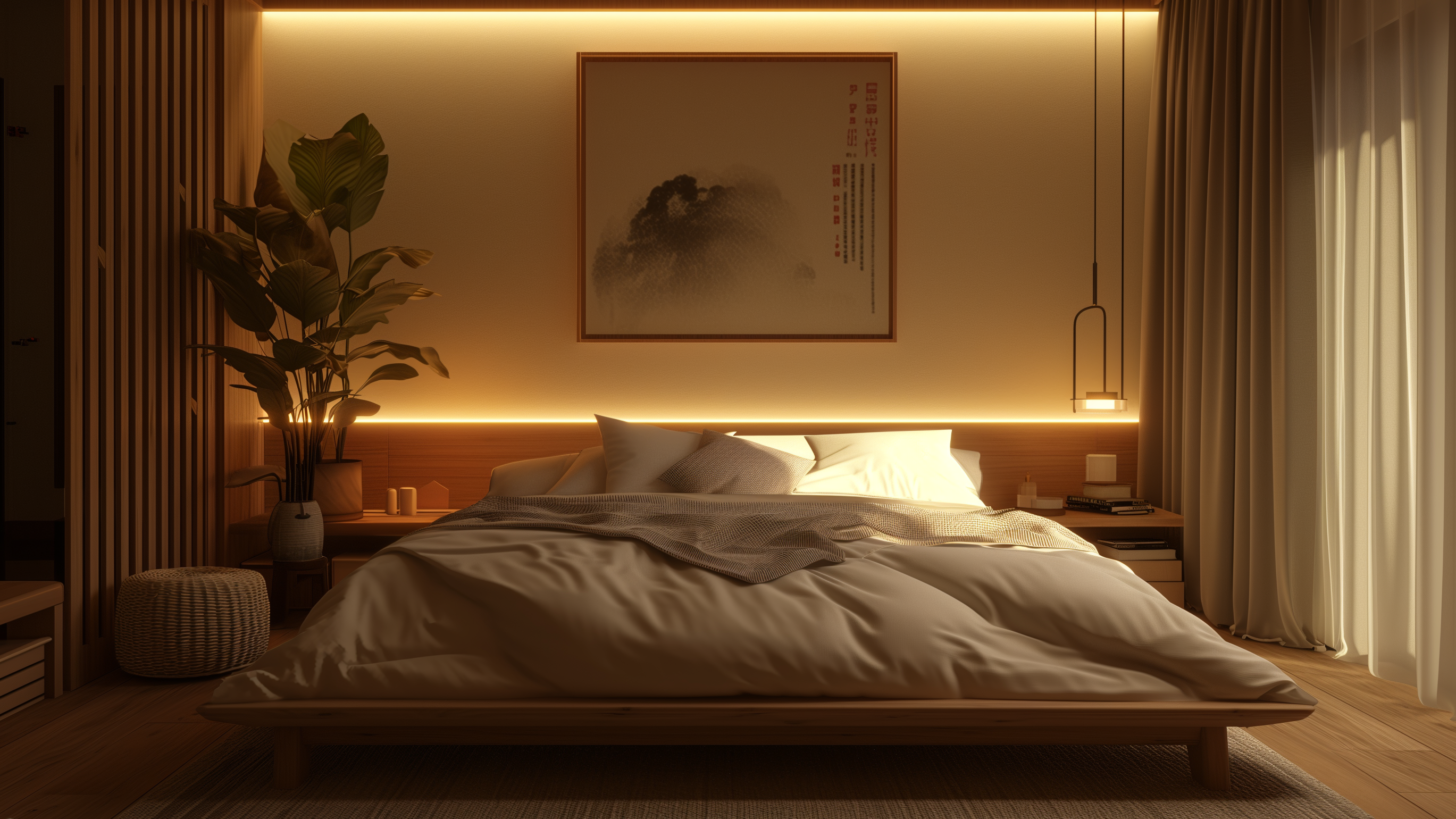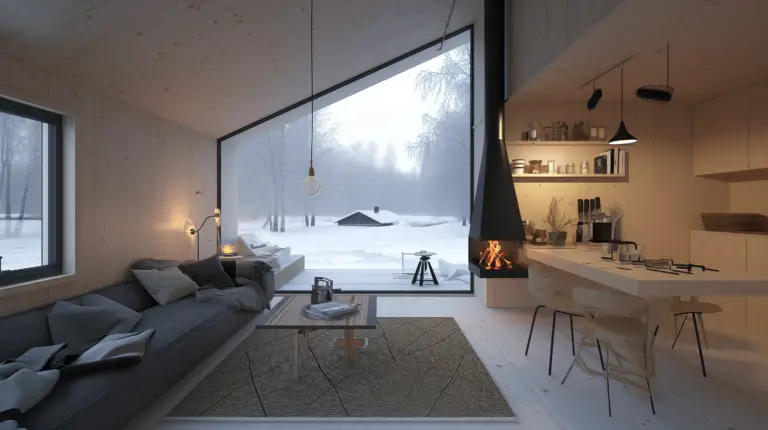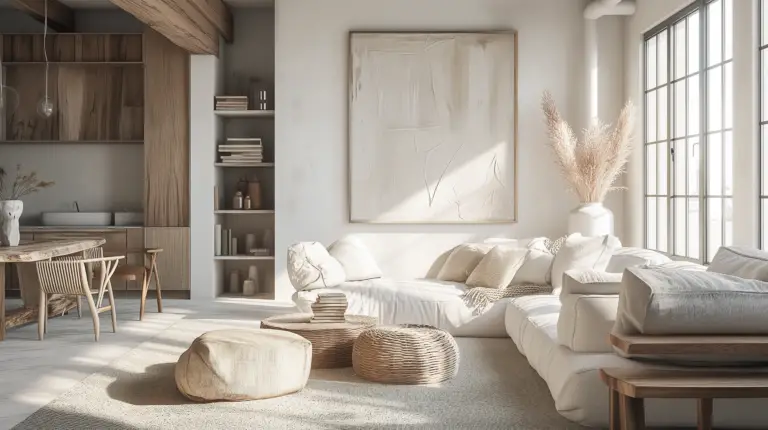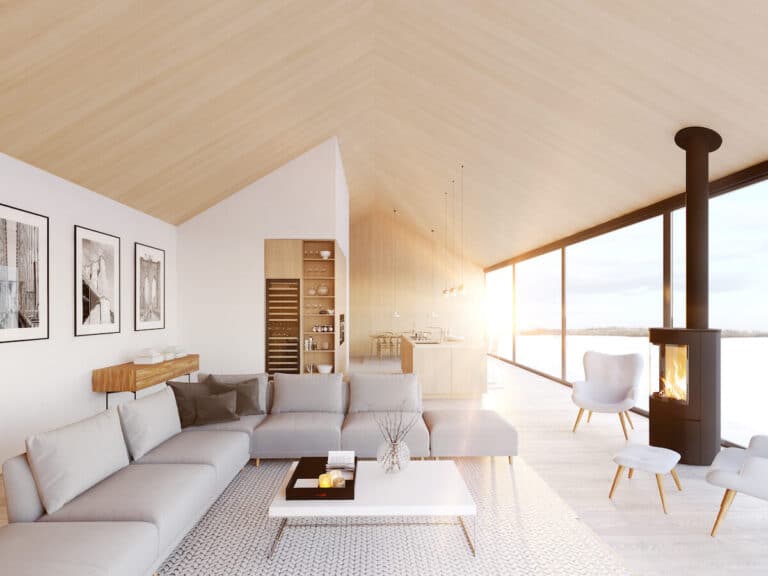Free Shipping On All Orders
15 Japandi Bedroom Ideas 2024 You Need to Know

Principles of Japandi Design
In Japandi design, you’ll find an aesthetic that prizes harmony and balance.
The principles guide you to create spaces that are serene and functional, emphasizing the beauty of simplicity and natural materials.
Simplicity and Minimalist Aesthetic
Simplicity is at the core of Japandi design. Your space should embody a minimalist aesthetic, fostering a clutter-free and tranquil atmosphere.
Furnishings with clean lines contribute to this minimalist approach, ensuring every piece has a purpose and place. This design choice not only enhances the visual appeal but also promotes a practical and uncluttered living environment.

Embracing Nature and Natural Materials
Japandi design encourages bringing the outside in. You are to use natural materials such as wood, stone, and bamboo, which add warmth and texture to your space.
Embrace nature not just through materials but also through natural light, which plays a pivotal role in creating an inviting and serene bedroom retreat.

Functionality and Clean Lines
Finally, Japandi spaces focus on functionality. In your bedroom, every element should be functional, with clean lines that avoid any form of visual noise.
Choose functional pieces that serve a clear purpose and contribute to a calming environment. Your bedroom should be a place of rest and relaxation, unencumbered by unnecessary decoration.

Creating the Japandi Ambiance
To establish a Japandi bedroom ambiance, your focus should be on cultivating serenity and warmth through your choice of colors, lighting, and a balanced approach to the space.
Neutral Color Palette and Muted Tones
Your Japandi bedroom should feature a neutral color palette to inspire a sense of calm. Think of hues that mimic natural elements like:
- Soft beiges: Resembling sandy beaches
- Greys: Evoking the color of pebbles
- Off-whites: Reflecting clouds
These muted tones help to create a backdrop that feels tranquil and uncluttered, essential for a Japandi space.

Incorporating Natural Light and Airiness
To capture that airy Japandi feel, allow as much natural light to enter your bedroom as possible. This might mean:
- Choosing light, sheer curtains
- Positioning furniture to maximize sunlight
The presence of natural light enhances the serenity and creates an inviting, cozy atmosphere all through the day.

Balancing Tranquility and Warmth
Creating a balance between tranquility and warmth is crucial. You can achieve this by:
- Introducing textures like soft linens and chunky knits
- Adding wooden elements that bring a touch of nature indoor
These touches of warmth make the space relaxed and welcoming. Remember, a Japandi bedroom is not just a visually calm space, but also one that offers a tactile sense of comfort.
Furniture and Layout
In crafting a Japandi bedroom, the emphasis is on selecting furniture that speaks to both style and functionality. Your choices should create a serene atmosphere, conducive to relaxation, while maintaining a clean and uncluttered environment.
Selecting Key Furniture Pieces
Choose key furniture pieces that embody the Japandi aesthetic; look for simple, elegant lines with a focus on natural materials like wood.
A platform bed is a quintessential choice for its low-profile, minimalist design and often comes with built-in storage solutions to maintain an uncluttered space.
- Bed: Opt for a wooden platform bed that complements a neutral color palette.
- Nightstands: Select pieces with clean lines, preferably made of natural wood with minimal detailing.

Functional and Multi-Functional Items
Incorporate multi-functional furniture in your bedroom to maximize space. This aligns with the Japandi principle of functionality and simplicity.
- Bench: A wooden bench at the foot of the bed can serve as seating or as a place to lay out tomorrow’s clothes.
- Desk: If space allows, a simple, elegant desk could also function as a vanity.

Maximizing Space with Minimal Clutter
The Japandi style is about breathing space and order, so your layout should be strategic. Use storage solutions that blend seamlessly with the room’s design, reducing clutter.
- Closet Organizers: Consider installing organizers that keep belongings neatly stored away.
- Under-bed Storage: Utilize the space beneath your platform bed for additional hidden storage.

Textiles and Soft Furnishings
In a Japandi bedroom, textiles and soft furnishings play a crucial role. They not only add layers of texture and warmth but also contribute to the overall aesthetic of simplicity and natural elegance. Careful selection and coordination are essential for creating a harmonious space.
Choosing Natural Fibers
When you select textiles for your Japandi bedroom, prioritize natural fibers. These materials are key to achieving both the aesthetic and sensory experience the style is known for.
- Linen: A highly breathable material which ensures a relaxed look and an airy feel.
- Cotton: Provides a soft touch and adds to the simple, unpretentious comfort.
- Wool: Wool rugs or throws can introduce warmth without compromising on natural texture.
Incorporating these fibers into your bedroom’s design should be a thoughtful process, considering both the tactile and visual comfort they provide.
Combining Comfort with Elegance
To imbue your space with the serene elegance inherent to the Japandi style, blend comfort and sophistication through your choice of textiles and soft furnishings.
- Rugs: Opt for understated wool or cotton rugs that complement the neutral color palette of the room without overpowering it.
- Curtains: Choose lightweight linen or cotton curtains that allow natural light to filter through, softening the overall impression of the space.
The textiles you choose should align with the reserved and chic nature of the décor, elevating the essence of Japandi interiors while maintaining a comfortable and inviting bedroom environment.

Decorative Elements and Accessories
In a Japandi-style bedroom, the selection of decorative elements and accessories is vital to achieving a balance in interior design. Your choices should be purposeful, accentuating the minimalist aesthetic while adding warmth and a touch of nature to the space.
Integrating Plants and Greenery
Plants play a key role in infusing life into your Japandi bedroom. In selecting greenery, opt for:
- Ferns and Bamboo: Provide a lush, Asian-inspired feel while also thriving indoors.
- Peace Lily, Snake Plant: These are low-maintenance options that clean the air.
Use simple vases or ceramic pots that reflect the natural elements of the design. The use of raw materials like stone or terracotta complements the organic look.

Using Decorative Items Sparingly
Limit your use of decorative items to a few meaningful pieces that align with the Japandi ethos. Focus on:
- Textural contrasts: Combine soft textiles with smoother woods.
- Natural palettes: Select items in neutral, earthy colors.
Accessories such as stone sculptures or wood-carved bowls should be used sparingly and serve as a functional element in the room. This less-is-more approach ensures that each item is chosen with intention.
Lighting and Accessories
In the Japandi bedroom, the harmony of lighting and accessories sets the tone. Achieving a balance between functionality and style is paramount, focusing on elements that provide both focused and ambient lighting, along with subtle decorative touches that uphold the aesthetic.
Focused and Ambient Lighting
For focused lighting, consider clean-lined, wall-mounted sconces placed strategically next to your bed. These offer direct light, perfect for reading without overwhelming the space.
Your nightstands can be enhanced with minimalistic lamps that complement the serene vibe.
Ambient lighting should be soft and warm, enhancing the cozy aspect of the Scandinavian influence while maintaining the Japanese minimalism. Options include:
- Dimmable ceiling lights for overall illumination
- Pendant lights with natural materials, letting out a diffused glow
- Floor lamps tucked in corners, providing layers of light

Subtle Decorative Touches
The headboard can be a statement piece crafted from raw, natural wood, adorned with simple yet elegant lines. For accessories:
- Choose items made of ceramics or wood with understated beauty
- Opt for a limited color palette to keep the aesthetic cohesive
- Incorporate plants in clean-lined pots for a touch of nature
Accessories should be functional and chosen with intention, avoiding clutter and maintaining the tranquil simplicity that Japandi interiors are known for.
Customization and Personal Touches
Your Japandi bedroom is not just a trend to follow; it’s a space where your personal narrative intertwines with the principles of Japanese design and Scandinavian interiors. It is where the artisanal meets minimalism, and the imperfect finds its place.
Incorporating Artistic Crafts
In a Japandi space, every object matters. Choose handcrafted items that speak to your style and elevate your room’s design. Here are ideal crafts you might include:
- Ceramics: Select pieces that carry the earthy tones and textures of Scandinavian interiors.
- Textiles: Opt for natural fabrics like cotton, linen, and wool that echo the tactile quality found in both Japanese design and Scandinavian decor.

Applying Wabi-Sabi Philosophy
Embrace wabi-sabi, the Japanese ethos of finding beauty in imperfection. This can translate into:
- Selecting furniture with a natural finish or slight irregularities that reflect true craftsmanship.
- Incorporating asymmetrical arrangements of decor, which can add a serene and authentic quality to the room.
Integrating Japandi into Existing Interiors
Introducing Japandi into your bedroom doesn’t have to mean a complete overhaul. With strategic choices and an understanding of key Japandi principles, you can seamlessly blend this style into your existing space.
Combining Japandi with Other Styles
When you introduce Japandi into your bedroom, aim for a harmonious blend rather than a clash of cultures. Japandi decor plays well with minimalist and modern designs, as it shares a love for clean lines and uncluttered spaces.
If your room currently features bold colors or busy patterns, consider toning these elements down with neutral shades and natural materials typical of Japandi style.
A Japandi style bedroom often uses a palette of soft whites, greys, and earth tones, making it flexible to integrate with many existing interiors.
- Color Balance: Incorporate earthy tones to complement existing vibrant colors.
- Furniture Silhouettes: Look for pieces that reflect a Scandinavian simplicity or Japanese minimalism, depending on your current style.
- Textural Contrast: Mix textures using fabrics like linen or cotton to add depth.
Minor Updates for Major Impact
You don’t need to enlist an interior designer to infuse Japandi elegance into your bedroom. Small changes can create significant impact:
- Accent Pieces: Replace or add a few key items like a tatami mat, a shoji screen, or Scandinavian-inspired art.
- Lighting: Introduce lighting that evokes a sense of calm and warmth, consistent with the Japandi ethos of serenity.
- Declutter: Embrace the minimalist aspect by decluttering, which is essential to both Japanese and Scandinavian styles.
- Plants: Add greenery that enhances the room’s Zen-like quality without overwhelming the space.
Remember, Japandi is as much about the feel of the space as it is about the aesthetics. The updates should promote a tranquil and cozy atmosphere, reflective of Japandi’s core design principles.
Design Tips and Trends
In Japandi bedrooms, the amalgamation of Japanese minimalism and Scandinavian hygge brings about a unique balance of aesthetics. Embrace this fusion in your space to create a calm and tranquil environment.
Current Trends in Japandi Design
- Natural Lighting: Maximizing natural light is key. Large windows that allow light to permeate the space are a staple in Japandi design trends, connecting you to the outdoors.
- Neutral Color Palettes: Soft earth tones and neutral color palettes create a serene ambiance. Colors that reflect nature, such as greens, browns, and greys, are especially popular.
- Functional Simplicity: Furniture with clean lines and practical use dominates, adhering to the minimalist aspect of Japandi. This trend is about choosing pieces with purpose, reducing clutter for a clean aesthetic.
Tips for Achieving the Japandi Look
- Select Natural Materials: Incorporate materials like wood, wool, and linen. These create a textural richness while maintaining simplicity.
- Wood: Use it for furniture and accents.
- Wool/Linen: Consider these for your bedding or draperies.
- Favor Quality Over Quantity: Choose a few high-quality pieces rather than many lower-quality items. This not only reduces clutter but also ensures a timeless sense of style.
- Integrate Plants: Bring living elements into your Japandi bedroom. Plants are a perfect way to add a touch of Japanese Zen and Scandinavian life appreciation.
- Soft Lighting: Instead of harsh lighting, opt for softer, diffused light sources to enhance the hygge element.
- Consider wall sconces, floor lamps, or candles.
By integrating these design tips and trends, you enrich your bedroom with the distinct, tranquil essence of Japandi living.
Practical Considerations
When creating a Japandi bedroom, it’s crucial to balance aesthetic appeal with functional, real-world applications. Here are pragmatic ways you can adopt the Japandi style.
Affordable Japandi Solutions
- Furniture: Opt for multi-functional furniture that embodies Japandi’s minimalist ethos. Look for affordable flat-pack options that offer a clean, simple design.
- Decor: Select a few quality pieces that speak to the Japandi style. Use plants, textile throws, and artwork to bring in natural elements without overspending.
- DIY: Embrace the DIY approach. Simple modifications to existing items can often introduce a Japandi feel—think along the lines of a coat of white paint or a new fabric cover.
Maintenance and Care for Japandi Spaces
- Materials: Pay attention to the materials you select. Durable materials like solid wood or bamboo will last longer and require less frequent replacement.
- Routine: Establish a regular cleaning routine to maintain the serene atmosphere. Dusting and decluttering are key activities that preserve the minimalist nature of the space.
- Products: Use gentle cleaning products designed for natural materials to protect your investment and ensure the longevity of your Japandi elements.
Japandi on a Budget
Creating a Japandi-style bedroom doesn’t have to strain your budget. This design philosophy marries the functional comfort of Scandinavian design with the sleek minimalism of Japanese aesthetics. Here are affordable ways to bring this serene style into your space:
Shop Smart
- IKEA: Leverage budget-friendly stores like IKEA for the basic pieces.
- Second-Hand: Look for second-hand items that can be upcycled.
DIY Projects
- Paint: Freshen up old furniture with neutral paint.
- Personal Touch: Add simple, personal touches like handmade pottery or textiles.
Budget-Friendly Decor
- Plants: Incorporate greenery with low-cost plants.
- Accessories: Use inexpensive, natural materials like bamboo and stone.
Keep it Simple
Remember, Japandi emphasizes minimalism, so there’s no need for excessive accessories.
Focus on quality over quantity and select items that truly resonate with the peaceful ambience of the style. Your aim is to curate a space filled with intentional pieces that evoke calm and tranquility.
By carefully choosing items, tapping into your DIY skills, and repurposing existing furniture, you can achieve the Japandi look without overspending. Stay true to the ethos of simplicity, and you’ll find that each element of your budget-conscious choices contributes to a harmonious and restful bedroom.







Frequently Asked Question
The key elements of a Japandi bedroom include minimalistic design, natural materials, neutral color palette, and a mix of Japanese and Scandinavian furniture.
To create a Japandi bedroom on a budget, focus on decluttering, using natural materials like wood and bamboo, incorporating simple and functional furniture, and opting for neutral colors.
Some tips for styling a Japandi bedroom include incorporating greenery, using soft and natural lighting, adding texture with textiles, and embracing the concept of wabi-sabi – finding beauty in imperfection.
If you liked this post about Japandi Bedrooms, don’t forget to follow us on Pinterest so you don’t miss any more interior design news!







